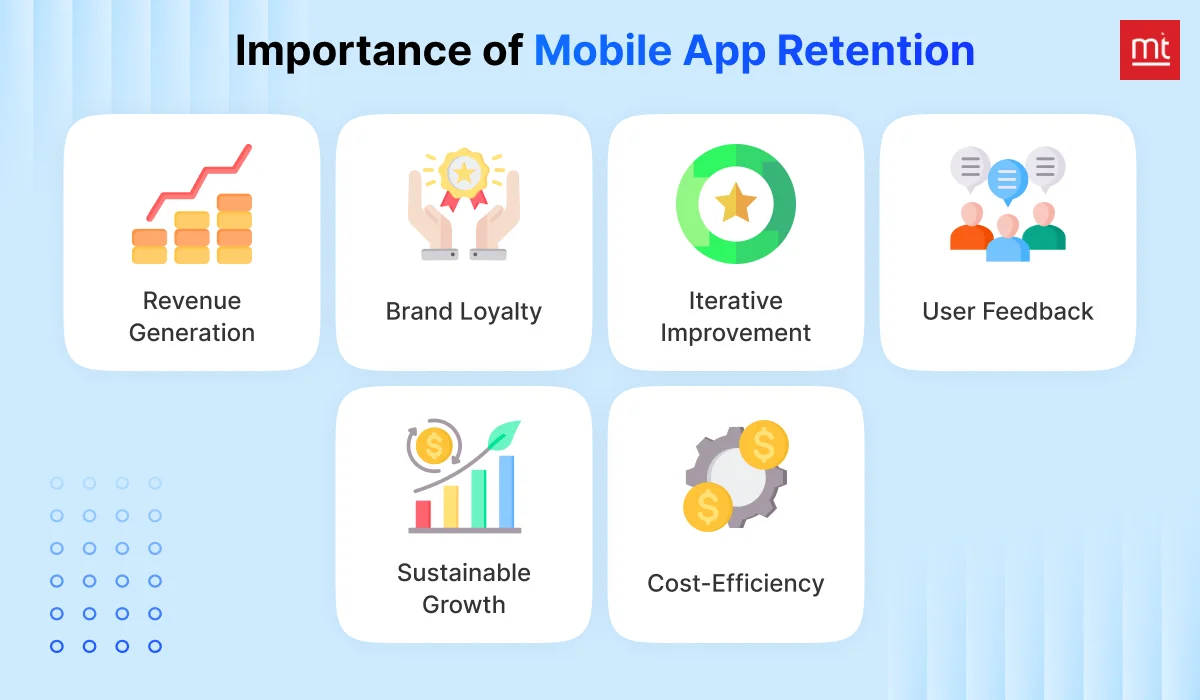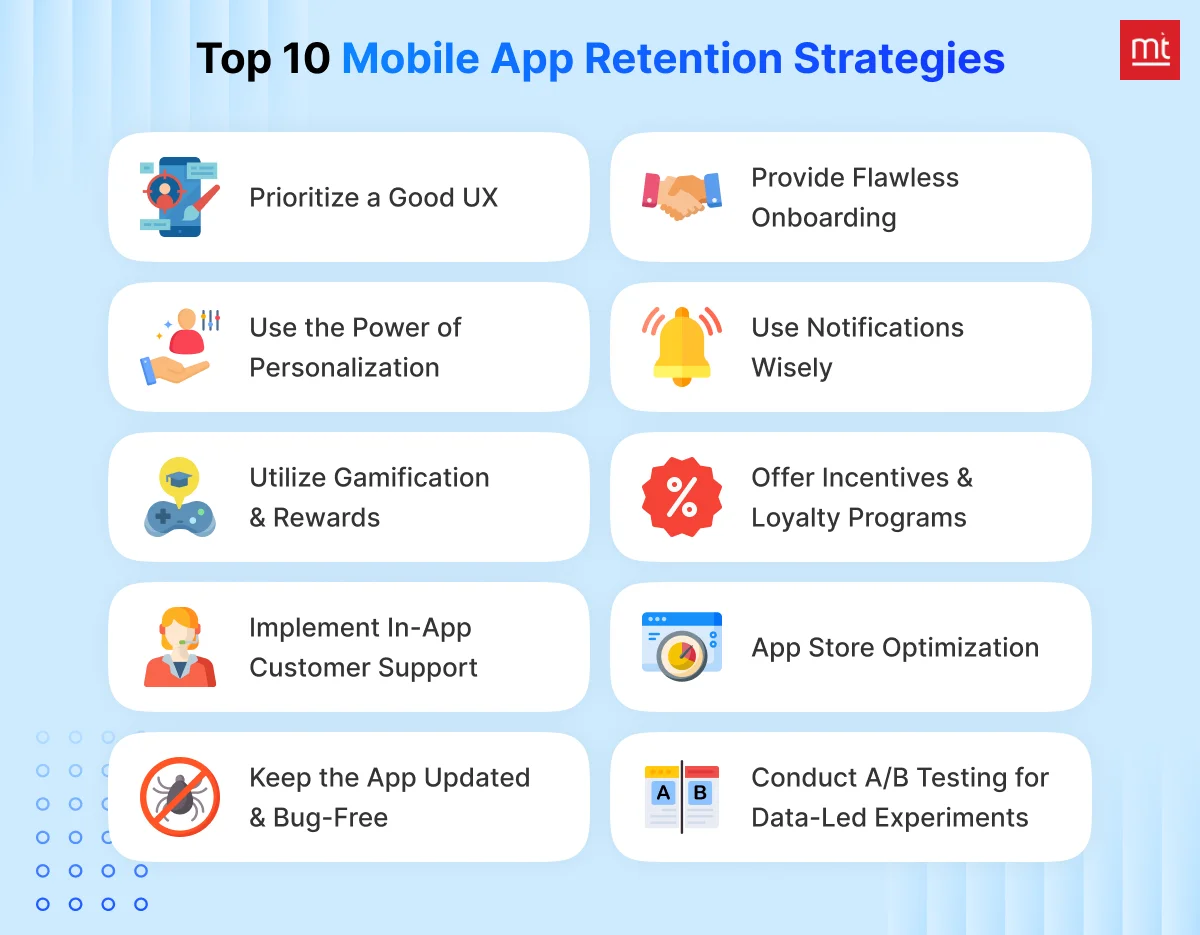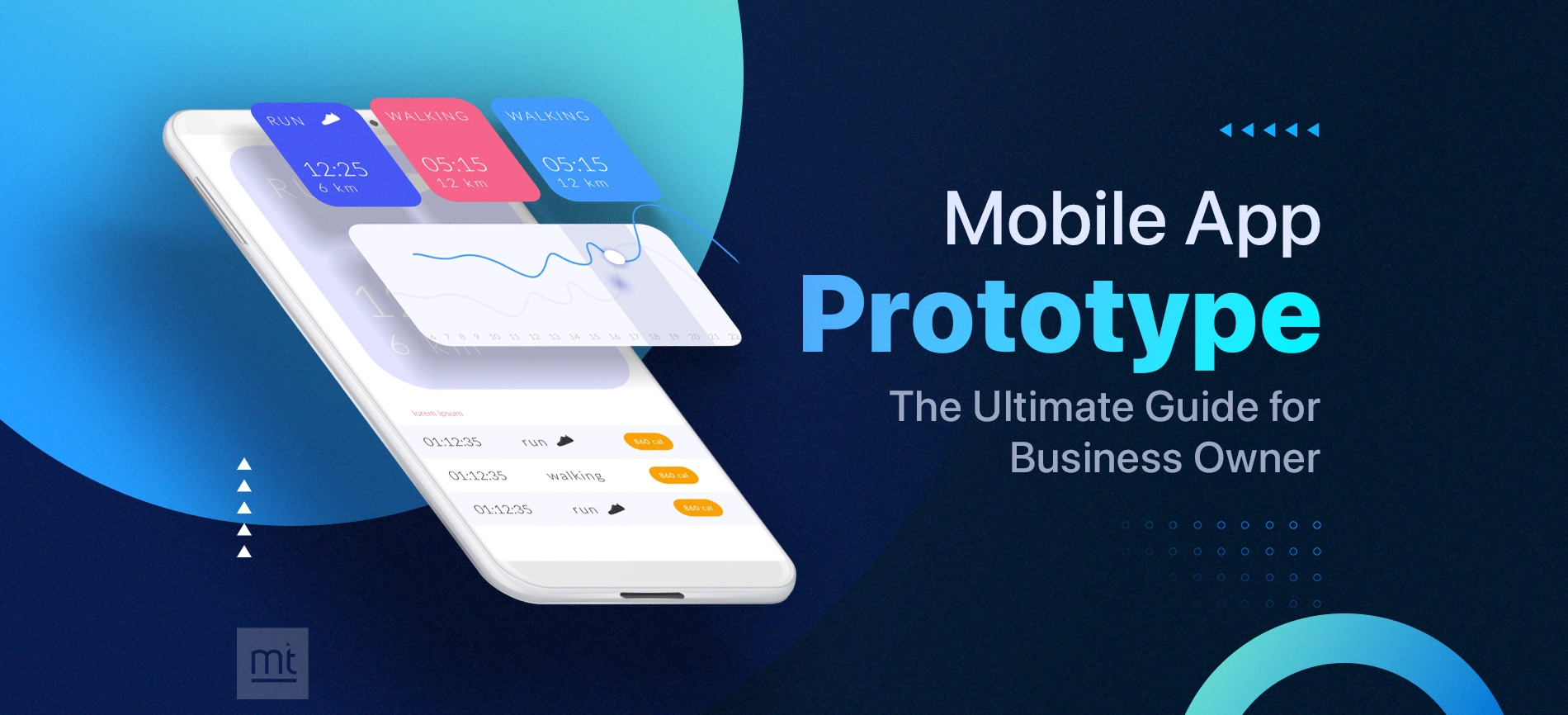Key Takeaway:
The success of a mobile app depends on its retention rates. In this blog, you will learn strategies on how to keep users coming back after the first download.
- Discover the power of personalized experiences and how to analyze retention on mobile apps.
- How to measure mobile app retention and top strategies for boosting long-term user engagement.
- The difference between acquisition vs. retention and how to balance both.
- Read actionable strategies related to onboarding, UX, notifications, loyalty programs, and more.
Introduction
Do you know that an average app typically loses 77% of its active users in the first 3 days after install? This shows that just getting millions of downloads is not enough; keeping users engaged with the app is what matters most. Imagine spending thousands on marketing to acquire new users, and most of them disappear within days. Personalization, good app design, and gamification, and many more are great for retaining users. But to build long-lasting relationships, generate stable revenue, and see sustainable growth, learning tailored mobile app retention strategies is crucial.
In this blog, you will explore what mobile app retention really means, why it’s so important, and proven strategies to keep users engaged, satisfied, and returning to your app consistently.
Mobile App Retention Rate Statistics
- According to Statista reports, among all categories, news, business, and shopping apps have the highest retention rates, which is 9.9%.
- Average Day-1 retention is around 25%, which only ¼ of new users return the next day.
- Japan ranks as the top in 30-day mobile app retention, and China has lowest retention, i.e 1.5%.
- Apps with a fast onboarding (under 1 minute) see 50% higher user retention.
- Sending push notifications three times a week can boost user retention by up to 190%.
- The 30-day retention rate is 2.6% for Android apps and 4.3% for iOS apps.
What is Mobile App Retention?
Mobile app retention simply means how many users keep coming back to your app after installing it. It measures whether people find your app useful enough to continue using it after the first use.
If retention is high, this means your app provides real value. If it’s low, it means it's not useful for users.
Why is Mobile App Retention So Important for App Growth?
Retention is the true growth factor for mobile app success. Downloads may bring the customers to your app, but retention is what keeps users using it again and again.
Here is why mobile app retention is important for any business growth.

1. Revenue Generation
It generates revenue for your mobile. When a user uses your app for a long time. They are likely to get converted into paid customers through subscriptions or ads. If your mobile app solves users' problems and is useful, retained users are more likely to become long-term customers. Plus, the users who are already using the app will also recommend it to their friends and other connections, which will save you extra costs in marketing, promotions, and advertising.
Hence, instead of counting the number of app downloads, focus on creating a loyal user base. This will automatically increase your revenue.
2. Brand Loyalty
When users keep returning to your app, it means they’ve built trust in your brand. When you deliver consistent value and a good experience to users, users give positive reviews and also refer the app to others, which helps convert casual users into loyal users.
This loyalty builds long-term relationships, which are far more valuable than short-term gains from new downloads.
3. Iterative Improvement
App retention helps you to learn from the users and their behaviour, like what they love and things they find useful and interesting about the app. By keeping users engaged, you can experiment, gather insights, and roll out updates according to the latest mobile app development trends.
4. User Feedback
When people stay engaged with your app for a long time, they naturally start sharing their experiences of what they love, what frustrates them, and what they’d like to improve. This will give you direct insight and improve things that actually matter for users.
This helps you to keep your app aligned with user expectations.
5. Sustainable Growth
If users are stuck using your app, you don't have to find new users every week and month. Once you have created a reliable base of active users, you will not need to spend a heavy budget on new acquisitions. Loyal users use your app repeatedly, recommend it to others, and even provide feedback that improves the product. This is a win-win situation from all sides.
This will continuously push your business towards sustainable growth.
6. Cost-Efficiency
Acquiring new users is costly, while retaining existing ones costs much less. High retention means you will spend fewer resources on constant acquisition campaigns and focus on nurturing the users you already have.
This not only saves money but also improves ROI and makes your marketing and growth efforts much more efficient.
How to Calculate Mobile App Retention Rate?
Mobile app retention rate is the percentage of users who return to your app within a specific time period, like after a day, a week, or a month. It helps you see if users enjoy your app enough to keep using it.
Knowing your retention rate is important because it shows if your app is truly valuable to users. High downloads should not be the goal. The goal should be to make users use your app again and again. By tracking retention, you can see if people enjoy your app, find weak spots in user experience, and make improvements to keep users connected to your app.
You must calculate your mobile app retention rate at different milestones, such as right after sign-up, during the first week, and after one month. This will give you a clear picture of short-term engagement and long-term loyalty.
First, you need to know the following things to calculate the mobile app retention rate.
- Time-frame: It is the usage pattern where users use your app for a week, a month, a quarter, or specific days.
- Initial user count: Consider the number of users who started to use your app from the beginning.
- Number of retained users: Retained users means the users who continue to use your app till a suitable period of time.
Here is the formula for how you can calculate the average mobile app retention rate.
Retention Rate (%) = (number of active users at the end of period/ number of users at the start of period)*100
For example: If you had 1,000 users on Day 1 and 250 of them are still active on Day 7, your 7-day retention rate = (250 ÷ 1000) × 100 = 25%.
So, what’s a Good Retention Rate?
If your retention till is minimum 40% at day 1 and around 25-30% till day 7, then it's a good retention rate.
- Average: 15–20% (Day 7)
- Poor retention: Below 10% (Day 7)
In simple terms, if more than a quarter of your users are still active after a week, your app is doing well.
Top Strategies to Enhance User Retention of Mobile App
User retention requires smart planning and consistent effort. If you want to keep users engaged after download, here are 10 proven strategies to boost retention and build loyal users.

1. Prioritize a Good UX
UX is your first impression that users feel on their first visit. A good UX can increase your user retention rate by 400%. 94% of visitors judge a first impression by good UX. If your app loads easily, has a clean design, and is easy to navigate, then it has a good UX. You must keep the smooth UX from the installation, onboarding, till the end of usage. Use the colors and themes relevant to your brand and service so users feel familiar and learn to use it quickly.
2. Provide Flawless Onboarding
Onboarding is where users decide if they’ll continue using your app. Proper onboarding can increase the retention rate up to 50%. Over 25% of users leave the app after a single use. The reasons why your users leave might be mostly poor onboarding. Keep the onboarding welcoming: short, simple and guided. Users must understand the benefit of using your product, use clear instructions, optional tutorials, and smooth sign-up processes.
This way, you can reduce churn and build confidence from day one.
3. Use the Power of Personalization
Do you know 71% of users expect personalization? There are 61% chances of turning users into repeat customers when you use personalization. Make your app tailored to your target audience. Provide services, recommendations, and other services personalized to their data, behaviour, and other actions they take on your app.
When users see content that fits their needs, they engage more. For example, Netflix recommends shows you’ll likely enjoy it keeps you coming back. Without personalization, apps will feel generic and lose relevance. So do your personalization right.
4. Use Notifications Wisely
46% of users who opt for push notifications will use the app at least 11 times. Notifications are powerful but only when it's used smartly and relevantly. About 54% of users who get personalized push notifications take action after opening them. Use your notification wisely, send alerts only about discounts, reminders, or updates they care about. Consider timely, relevant, and personalized notifications to avoid spamming.
Remember the key is to notify users and add value, but never to irritate.
5. Utilize Gamification & Rewards
Gamification is the best way to motivate users to take action, complete tasks, and earn rewards. This way, users enjoy using your app and engage with it. Add game-style onboarding like points, badges, or progress tracking. Rewards give users something extra to stay active, like discounts or special access.
This is the natural way of connecting with users and make them feel recognized and valued. The best example of gamification is Duolingo, which keeps users hooked with streaks and rewards.
6. Offer Incentives & Loyalty Programs
Giving incentives and rewards is the best way to keep the user stay on your app. You should give them concrete reasons to use your app. This can be done by offering discounts, free trials, or loyalty points. Suppose you are an e-commerce business, you can offer cashback or exclusive deals to returning customers, which encourages them to repeat purchases. Over time, this will make users addicted to using your app and increase the chances of coming back.
7. Keep the App Updated & Bug-Free
Keep updating your app and monitoring it from time to time. Take help from an Android app development company or any good iOS app development services, depending on your app platform, to keep updating it from time to time. Introduce new features that keep the user experience alive and fresh. Regular updates show that you care about their experience.
Also, change your app store or play store content with new screenshots, videos whatever you change over time to notify the users.
8. Conduct A/B Testing for Data-Led Experiments
A/B testing lets you compare two versions of a feature, design, or message to see which performs better. Hire an experienced mobile app development agency to test each module of the app. Here are the areas of the app you must look at during A/B testing.
- In-app engagements: Test different button placements, CTAs, or layouts to see what keeps users active longer.
- Impact of new features: Check if new features actually improve usage or confuse users.
- Messaging of push notifications: Experiment with wording to learn what drives clicks and engagement.
- Timing of push notifications/alerts: Test whether morning, afternoon, or evening notifications get better responses.
- Onboarding flow: Compare shorter vs. detailed onboarding to see which keeps users from dropping off early.
- Custom events: Track unique actions (like adding to cart, saving favorites) and test flows to encourage repeat use.
9. Implement In-App Customer Support
When users face a problem, they want help fast. If they can’t get support inside the app, they’ll likely quit and never return. So it's important to add in-app support like live chat, FAQs, or AI assistants and solve users' problems as soon as possible.
It shows users you care about their experience and builds trust.
10. App Store Optimization
ASO is important to discover your users for whom you have made this app. Present your app well with strong keywords, clear descriptions, and positive reviews. When users know what to expect before downloading, they are more likely to stay. Plus, good ASO attracts the right audience. Users who are genuinely interested will definitely become great customers.
What’s the Difference Between User Acquisition and Retention?
User acquisition and user retention are two important terms if you are building a mobile app because it is directly connected to your business growth. Both play their role differently in app growth.
User acquisition simply means attracting new people to download and try your app. You need to run marketing campaigns, app store optimization (ASO), social media ads, referrals, or partnerships for this.
So basically, acquisition is the starting point that brings customers to your app.
On the other side, user retention is about keeping those users active and engaged over time. It’s not just about a single download; it’s about how you can keep them coming back to your app again and again.
Retention shows how valuable your app is to users. If people keep returning, it means your app is solving their real problem and delivering a good experience.
When should you focus on each?
- In the early stage of your app launch, acquisition is critical because you need users to test and grow.
- As your app becomes familiar, retention becomes more important. Because, logically, keeping users is more affordable than constantly finding new ones.
To conclude, user acquisition is about getting users in. User retention is about making them stay. When both work together with proper alignment, you will attract users as well as retain them.
Summing Up
Your entire business works on app retention, hence it is the backbone for app success. Above, we have discussed the top mobile apps user retention strategies to retain users for long-term engagement. It's not only about bringing users who download, it's about adding valuable features and functionalities in the mobile app that encourage users to use the app for a longer time. Most importantly, it should be natural, personalized, and relevant to them.
Remember, downloads alone don’t guarantee success; sustained engagement does. By applying our above strategies, you will easily reduce churn rates and build loyalty and drive sustainable growth for your app.
Want to learn how our strategies can help boost your app’s retention and growth? Book a free consultation with ManekTech and learn about the possibilities.
Subscribe to Our Newsletter!
Join us to stay updated with our latest blog updates, marketing tips, service tips, trends, news and announcements!





![How Much Does It Cost to Build a Mobile App? [Checklist]](https://www.manektech.com/storage/blog/image/1708005911.webp)
![How to Speed up Mobile App Development Process and Save Time? [Checklist]](https://www.manektech.com/storage/blog/image/1644828806.jpg)















